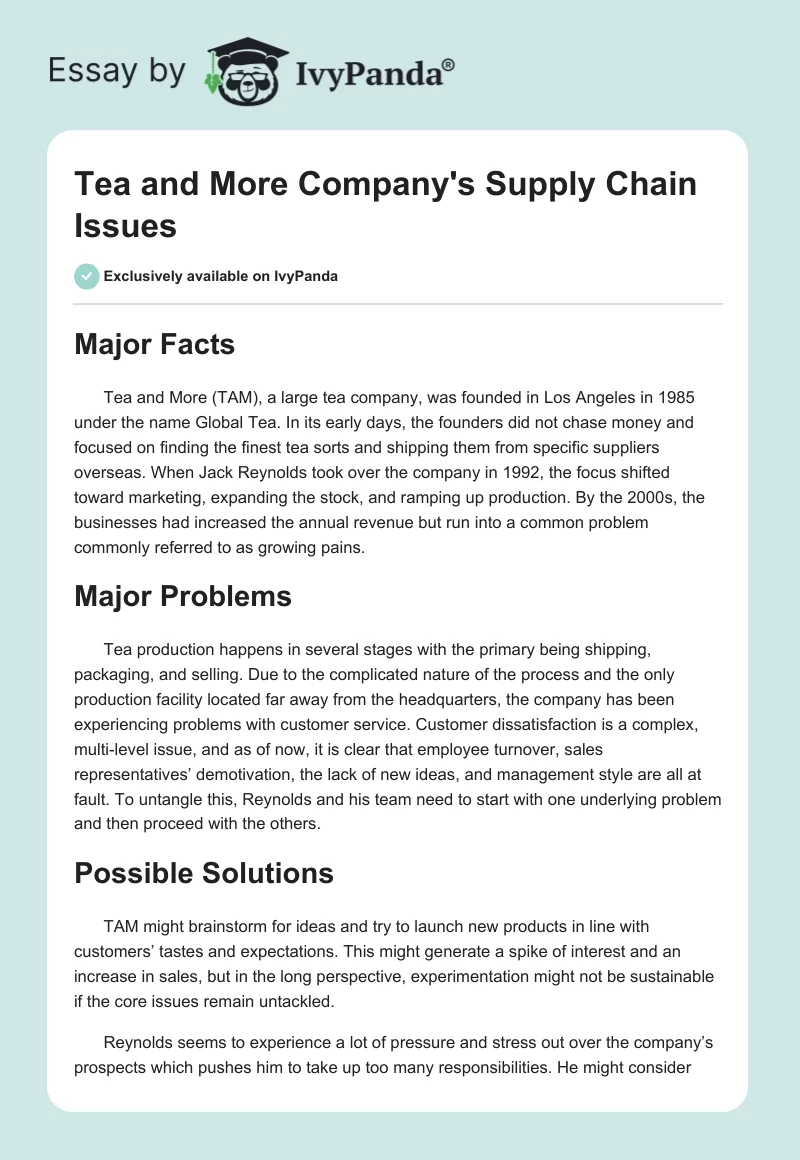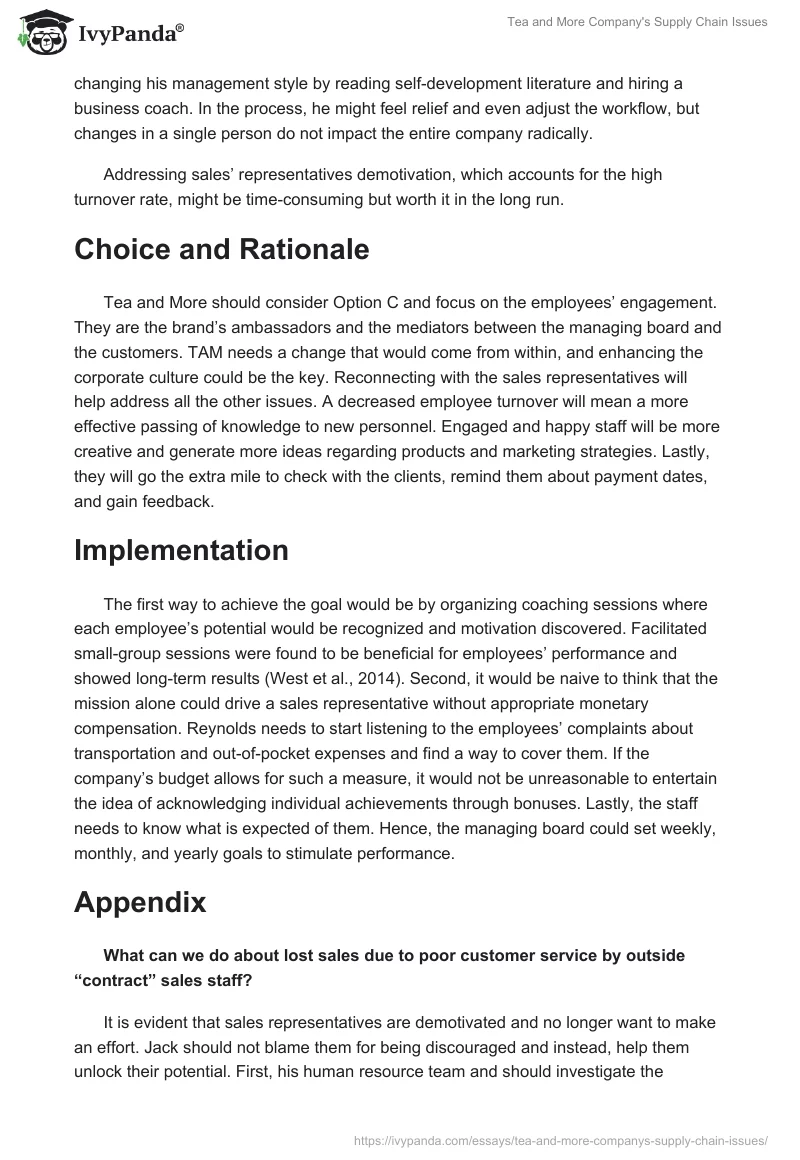Major Facts
Tea and More (TAM), a large tea company, was founded in Los Angeles in 1985 under the name Global Tea. In its early days, the founders did not chase money and focused on finding the finest tea sorts and shipping them from specific suppliers overseas. When Jack Reynolds took over the company in 1992, the focus shifted toward marketing, expanding the stock, and ramping up production. By the 2000s, the businesses had increased the annual revenue but run into a common problem commonly referred to as growing pains.
Major Problems
Tea production happens in several stages with the primary being shipping, packaging, and selling. Due to the complicated nature of the process and the only production facility located far away from the headquarters, the company has been experiencing problems with customer service. Customer dissatisfaction is a complex, multi-level issue, and as of now, it is clear that employee turnover, sales representatives’ demotivation, the lack of new ideas, and management style are all at fault. To untangle this, Reynolds and his team need to start with one underlying problem and then proceed with the others.
Possible Solutions
TAM might brainstorm for ideas and try to launch new products in line with customers’ tastes and expectations. This might generate a spike of interest and an increase in sales, but in the long perspective, experimentation might not be sustainable if the core issues remain untackled.
Reynolds seems to experience a lot of pressure and stress out over the company’s prospects which pushes him to take up too many responsibilities. He might consider changing his management style by reading self-development literature and hiring a business coach. In the process, he might feel relief and even adjust the workflow, but changes in a single person do not impact the entire company radically.
Addressing sales’ representatives demotivation, which accounts for the high turnover rate, might be time-consuming but worth it in the long run.
Choice and Rationale
Tea and More should consider Option C and focus on the employees’ engagement. They are the brand’s ambassadors and the mediators between the managing board and the customers. TAM needs a change that would come from within, and enhancing the corporate culture could be the key. Reconnecting with the sales representatives will help address all the other issues. A decreased employee turnover will mean a more effective passing of knowledge to new personnel. Engaged and happy staff will be more creative and generate more ideas regarding products and marketing strategies. Lastly, they will go the extra mile to check with the clients, remind them about payment dates, and gain feedback.
Implementation
The first way to achieve the goal would be by organizing coaching sessions where each employee’s potential would be recognized and motivation discovered. Facilitated small-group sessions were found to be beneficial for employees’ performance and showed long-term results (West et al., 2014). Second, it would be naive to think that the mission alone could drive a sales representative without appropriate monetary compensation. Reynolds needs to start listening to the employees’ complaints about transportation and out-of-pocket expenses and find a way to cover them. If the company’s budget allows for such a measure, it would not be unreasonable to entertain the idea of acknowledging individual achievements through bonuses. Lastly, the staff needs to know what is expected of them. Hence, the managing board could set weekly, monthly, and yearly goals to stimulate performance.
Appendix
What can we do about lost sales due to poor customer service by outside “contract” sales staff?
It is evident that sales representatives are demotivated and no longer want to make an effort. Jack should not blame them for being discouraged and instead, help them unlock their potential. First, his human resource team and should investigate the everyday stressors and try to eliminate them. Second, the world’s most successful companies pay plenty of attention to building a corporate culture. Strengthening social ties, organizing events, and fostering horizontal relationships might be the answer. Third, Jack needs to understand that while money cannot buy happiness, the lack thereof most certainly will make an employee unhappy. If he rejects the idea of raising salaries, he should pay for gas.
How can we restore the attractiveness and power of the TAM brand for major customers so they aren’t lured away by low-cost, low-quality competitors?
The brand has always capitalized on uniqueness and sophistication, which justified higher prices. TAM might want to continue showing customers what makes the company stand out among the contenders. For example, it might market its products as ethical and organic. Nowadays, many customers consider a producer’s vision and reputation when purchasing so that they might be won over by the ‘green’ rebranding.
How can we minimize “stock outages” and other inventory problems caused by the unpredictable customer ordering patterns and the continuing difficulty of getting faster production and delivery from EML in London?
TAM might benefit from past data analysis to predict future sales. Customers can be outstandingly unreasonable in their decisions, but a business owner can only do this much to motivate them to plan. First, since the company noticed that the same things happen every year, it can stock up on the most popular products and ensure that they are available up until the high season. Second, each interaction with a client can and should be personalized. A customer does not have a malicious intention by not purchasing enough and then demanding more products. Humans are forgetful and caught up in their routines, so a friendly, non-aggressive reminder via email might help.
How can we reduce collection time from 54 days to less than 40 days without alienating the very customer base TAM is trying to attract and retain?
When a business has to wait for the postal office to proceed with a payment, it might lose one to three days to the collection. Blaming customers for delayed payments is a natural but fairly unproductive way to react to the situation on hand. Now, payables and receivables can be easily calculated and terms adjusted so that the “float” time is reduced. The main problem is enforcing collection policies without repelling customers. One way to go about the issue is training personnel to use tracking software and making calls or sending letters with the payment is due. This strategy, however, might prove to be ineffective, and in this case, TAM might want to consider setting up a bank account for automated payments. This way, customers’ needs for easier money transfers would be met, and they would be more willing to comply.
What decisions should we make regarding experimentation with new tea varieties, such as the “Christmas Mint” tea that fell flat last season? Can we afford to continue such experiments? Can TAM afford to stick only to its basic teas and not compete in the “new and improved” tea market so heavily advertised by competitors?
It appears that the “Christmas Mint” flopped not because of its taste properties or overall quality but due to the poor effort to market it. Tea and More cannot afford to experiment with launching new products before developing a solid strategy. The marketing director might want to research the target audience and find appropriate advertising channels, be it traditional media or social networking. Apart from advertising, there is plenty of theoretical approaches such as VRIO-analysis that could be used to evaluate the uniqueness of an upcoming product. That being said, sticking to basic teas only contradicts the philosophy of the company built around rarity and sophistication.
What haven’t we thought of? Where else can financial advantages and process efficiencies be achieved?
Jack’s leadership style seems to be somewhat overbearing and could be classified as micromanagement. While caring about the company’s growth is a positive thing, his apprehension, and inability to delegate put a strain on his mental health and employees’ engagement. There is not enough information on how Tea and More handle human resources development issues, but the business would sure benefit from hiring a specialist that would evaluate the inner climate and offer solutions. Such a specialist could study the company’s vision closely and hire new staff in accordance with the company’s values. Further measures aimed at fostering a friendly corporate culture would reduce the turnover rate.
Reference
West, C. P., Dyrbye, L. N., Rabatin, J. T., Call, T. G., Davidson, J. H., Multari, A.,… & Shanafelt, T. D. (2014). Intervention to promote physician well-being, job satisfaction, and professionalism: a randomized clinical trial. JAMA Internal Medicine, 174(4), 527-533.


